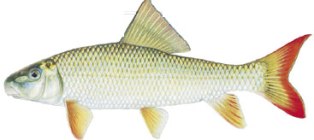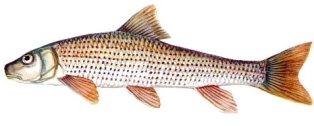Discover Florida Nature
It's time to explore the natural Florida


|
|
|
|
|
 Quillback
(Carpiodes cyprinus) Eight species of suckers occur
in Florida, including two species of Carpiodes
carpsuckers, the quillback and the highfin carpsucker. As their
common name implies, these silvery, deep-bodied fish resemble
common carp. However, both carpsuckers may be distinguished from
carp by the absence of barbels, and lack of spines in dorsal and
anal fins of the carpsuckers. In both carpsuckers, the mouth is
situated on the underside of the head and the snout extends
forward beyond the jaws; also, the first ray of the dorsal fin
may be very long, forming an elevated filament. Quillback and
highfin carpsuckers are very similar in appearance, but they may
be separated by looking at the lower lip. The quillback does not
have a nipple-like knob at the middle of the lower lip, while
the highfin carpsucker has a small nipple at this location. Both
carpsuckers may be distinguished from other Florida suckers by
body shape. The carpsuckers have deep, slab-sided bodies, while
our other suckers are more elongate or somewhat cylindrical in
shape. Quillbacks are benthic fish, feeding on the bottom and
ingesting insect larvae, other organisms and organic detritus.
They reproduce during March and April. Females may produce from
15,000 to 360,000 eggs apiece, which are broadcast over gravel
shoals or deep stretches of sand. They may live as long as ten
or eleven years, and may reach a maximum length of about 26
inches and maximum weight of 12 pounds. Quillbacks typically
inhabit moderately large streams, but may also live in creeks if
permanent pools are present. Quillback
(Carpiodes cyprinus) Eight species of suckers occur
in Florida, including two species of Carpiodes
carpsuckers, the quillback and the highfin carpsucker. As their
common name implies, these silvery, deep-bodied fish resemble
common carp. However, both carpsuckers may be distinguished from
carp by the absence of barbels, and lack of spines in dorsal and
anal fins of the carpsuckers. In both carpsuckers, the mouth is
situated on the underside of the head and the snout extends
forward beyond the jaws; also, the first ray of the dorsal fin
may be very long, forming an elevated filament. Quillback and
highfin carpsuckers are very similar in appearance, but they may
be separated by looking at the lower lip. The quillback does not
have a nipple-like knob at the middle of the lower lip, while
the highfin carpsucker has a small nipple at this location. Both
carpsuckers may be distinguished from other Florida suckers by
body shape. The carpsuckers have deep, slab-sided bodies, while
our other suckers are more elongate or somewhat cylindrical in
shape. Quillbacks are benthic fish, feeding on the bottom and
ingesting insect larvae, other organisms and organic detritus.
They reproduce during March and April. Females may produce from
15,000 to 360,000 eggs apiece, which are broadcast over gravel
shoals or deep stretches of sand. They may live as long as ten
or eleven years, and may reach a maximum length of about 26
inches and maximum weight of 12 pounds. Quillbacks typically
inhabit moderately large streams, but may also live in creeks if
permanent pools are present. River
Redhorse
(Moxostoma carinatum) In Florida the river redhorse is
known only from the Escambia River at the western end of the
Panhandle. Normally inhabitants of medium to large size rivers,
river redhorse may also enter tributary streams and have been
observed in reservoirs. They prefer clean rivers with sand,
gravel or cobblestone bottoms and swift currents. This robust,
cylindrical sucker may be separated from other similar Florida
suckers by its red tail fin. The dorsal and other fins may also
be red or reddish. The dorsal fin has a straight or slightly
concave margin and the tail fin has a pointed upper lobe which
usually is slightly longer than the rounded lower lobe.
Crescent-shaped dark spots may be visible on the scales of the
back and sides and the overall body color of the river redhorse
is olive to brownish across the back, with silvery or bronze
sides and a white underside. River redhorse feed primarily on
molluscs such as mussels and clams, and their enlarged,
molar-shaped, internal pharyngeal teeth are specially adapted
for crushing the hard shells of such bivalves. River
Redhorse
(Moxostoma carinatum) In Florida the river redhorse is
known only from the Escambia River at the western end of the
Panhandle. Normally inhabitants of medium to large size rivers,
river redhorse may also enter tributary streams and have been
observed in reservoirs. They prefer clean rivers with sand,
gravel or cobblestone bottoms and swift currents. This robust,
cylindrical sucker may be separated from other similar Florida
suckers by its red tail fin. The dorsal and other fins may also
be red or reddish. The dorsal fin has a straight or slightly
concave margin and the tail fin has a pointed upper lobe which
usually is slightly longer than the rounded lower lobe.
Crescent-shaped dark spots may be visible on the scales of the
back and sides and the overall body color of the river redhorse
is olive to brownish across the back, with silvery or bronze
sides and a white underside. River redhorse feed primarily on
molluscs such as mussels and clams, and their enlarged,
molar-shaped, internal pharyngeal teeth are specially adapted
for crushing the hard shells of such bivalves. Sharpfin
Chubsucker (Erimyzon tenuis) Sharpfin
chubsuckers inhabit streams of the western Panhandle of Florida,
from the Perdido River to the Yellow River. The sharpfin
chubsucker is superficially similar to the lake chubsucker, with
which it is occasionally found. As the common name implies, the
dorsal fin is sharply pointed, while that of the lake chubsucker
is rounded in profile. Usually the first ray of the dorsal fin
is longer than the base of this fin, while the first ray is
usually shorter than the fin base of the lake chubsucker. Both
of these chubsuckers are robust, oblong and somewhat compressed
fishes; however, they are not nearly as deep-bodied or
slab-sided as the carpsuckers and they have shorter dorsal fins
(containing less than 20 rays) than the carpsuckers. Conversely,
most other Florida suckers (spotted sucker and several redhorse
suckers) are much more elongate and slenderer than the
chubsuckers, and although the mouth of the chubsuckers is
slightly below the head, it is not nearly as far beneath the
head as that of the spotted sucker and the redhorse suckers. The
anal fin of the male sharpfin sucker is not bilobed as is that
of the male lake chubsucker. Breeding takes place in the spring,
probably March and April. They may reach a length of 16 inches
and may live seven or eight years. This is a fish of streams
rather than quiet waters; however, it does not prefer the
swifter waters favored by most suckers. Sharpfin
Chubsucker (Erimyzon tenuis) Sharpfin
chubsuckers inhabit streams of the western Panhandle of Florida,
from the Perdido River to the Yellow River. The sharpfin
chubsucker is superficially similar to the lake chubsucker, with
which it is occasionally found. As the common name implies, the
dorsal fin is sharply pointed, while that of the lake chubsucker
is rounded in profile. Usually the first ray of the dorsal fin
is longer than the base of this fin, while the first ray is
usually shorter than the fin base of the lake chubsucker. Both
of these chubsuckers are robust, oblong and somewhat compressed
fishes; however, they are not nearly as deep-bodied or
slab-sided as the carpsuckers and they have shorter dorsal fins
(containing less than 20 rays) than the carpsuckers. Conversely,
most other Florida suckers (spotted sucker and several redhorse
suckers) are much more elongate and slenderer than the
chubsuckers, and although the mouth of the chubsuckers is
slightly below the head, it is not nearly as far beneath the
head as that of the spotted sucker and the redhorse suckers. The
anal fin of the male sharpfin sucker is not bilobed as is that
of the male lake chubsucker. Breeding takes place in the spring,
probably March and April. They may reach a length of 16 inches
and may live seven or eight years. This is a fish of streams
rather than quiet waters; however, it does not prefer the
swifter waters favored by most suckers. Spotted
Sucker (Minytrema melanops) Spotted suckers
occupy streams of northern Florida, from the Perdido River,
eastward to the Suwannee River system. This species and the
redhorse suckers (genus Moxostoma) may be readily
separated from other Florida suckers (the carpsuckers,
Carpiodes, and chubsuckers, Erimyzon) by their
elongate, cylindrical bodies and distinctly sucker-like mouths
located well on the underside of the head. Spotted suckers and
the redhorse suckers have protrusible lips which they employ to
pick up food from the bottom and it is these extendable lips
which provide them with the amusing local name of buglemouth
bass. Spotted suckers may be identified by the presence of eight
to twelve parallel rows of dark spots which run along the sides
of the body. Overall body coloration is brassy or bronze, with
the upper back shading to olive or brownish and the bottom being
gray or white. Breeding males may have two dark bands running
along the sides, separated by a pinkish or reddish band along
the midline of the sides. Spotted suckers are bottom-feeders,
sucking up food items with their protrusible lips. They consume
copepods, cladocera, true midge larvae, aquatic earthworms,
biting midge larvae, water mites, aquatic beetles, mayfly
nymphs, dragonflies, stoneflies, caddisflies, and rarely, fish.
Spawning migrations begin during January, and reproduction
occurs through the spring. They may live about five or six years
and reach a maximum length of about 24 inches and maximum weight
of three pounds. Spotted
Sucker (Minytrema melanops) Spotted suckers
occupy streams of northern Florida, from the Perdido River,
eastward to the Suwannee River system. This species and the
redhorse suckers (genus Moxostoma) may be readily
separated from other Florida suckers (the carpsuckers,
Carpiodes, and chubsuckers, Erimyzon) by their
elongate, cylindrical bodies and distinctly sucker-like mouths
located well on the underside of the head. Spotted suckers and
the redhorse suckers have protrusible lips which they employ to
pick up food from the bottom and it is these extendable lips
which provide them with the amusing local name of buglemouth
bass. Spotted suckers may be identified by the presence of eight
to twelve parallel rows of dark spots which run along the sides
of the body. Overall body coloration is brassy or bronze, with
the upper back shading to olive or brownish and the bottom being
gray or white. Breeding males may have two dark bands running
along the sides, separated by a pinkish or reddish band along
the midline of the sides. Spotted suckers are bottom-feeders,
sucking up food items with their protrusible lips. They consume
copepods, cladocera, true midge larvae, aquatic earthworms,
biting midge larvae, water mites, aquatic beetles, mayfly
nymphs, dragonflies, stoneflies, caddisflies, and rarely, fish.
Spawning migrations begin during January, and reproduction
occurs through the spring. They may live about five or six years
and reach a maximum length of about 24 inches and maximum weight
of three pounds.
|
|
|
Advertise | Privacy Statement | Dog Encyclopedia | Video |Contact | Alaska Nature |
|